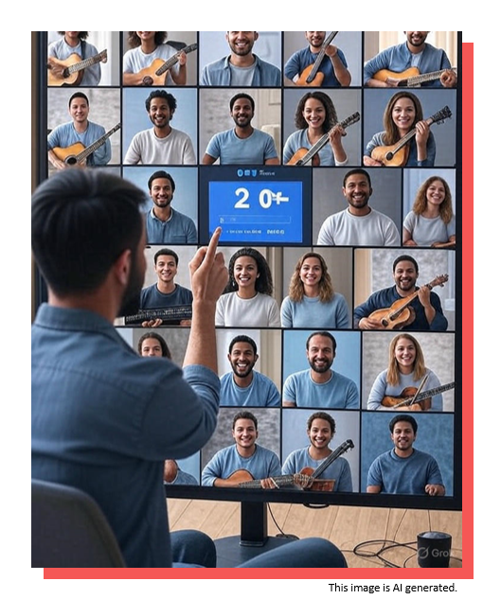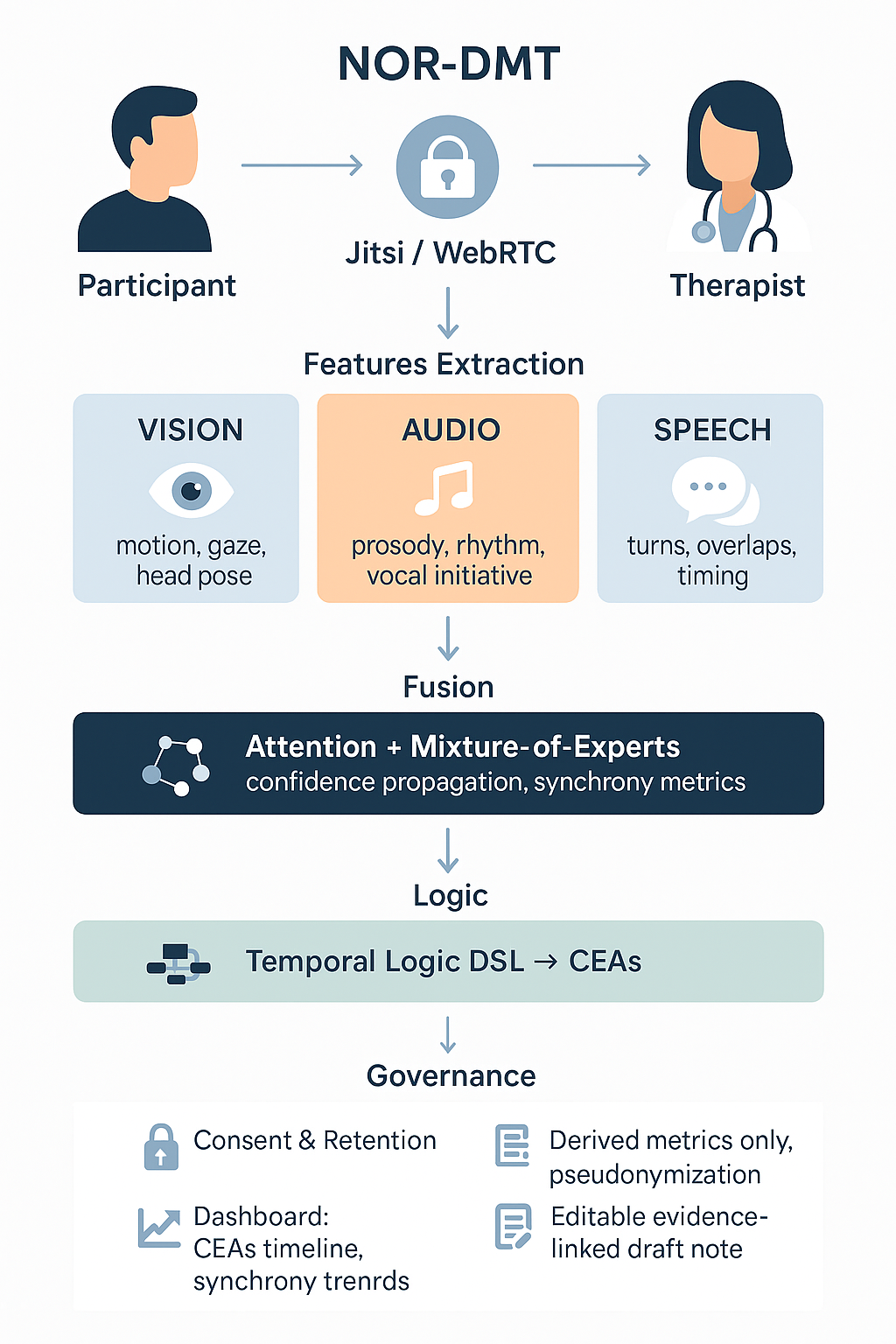A collaboration between NORCE Digital Systems, NORCE GAMUT, and HVL | EuroCC-funded Initiative | Technical Leadership: Dr. Hasan Asyari Arief

Figure 1: Virtual Group Music Therapy (vGMT) demonstrating how online sessions enable multiple participants to engage with instruments simultaneously through video conferencing
When therapy moved online in 2020, something fundamental was lost. The subtle cues that therapists rely upon—a shift in posture, the quality of silence, the energy in a room—all disappeared into the digital void. Virtual sessions could function, with multiple participants connecting through screens, but the real challenge became measurement. How do you measure engagement when your client is a thumbnail on a screen? How do you document progress when the very medium strips away the signals you've been trained to observe?
This wasn't just a music therapy problem. Every therapeutic discipline faced the same crisis of confidence. Virtual sessions were happening, clients were attending, but the question haunted every practitioner: is this actually working? The subjective observations that might suffice in person—"the client seemed engaged today"—felt hollow when filtered through pixels and bandwidth limitations.
How do we transform subjective observations into objective evidence when therapy happens through a screen?
This question led to NOR-DMT, a platform that makes virtual therapy measurable. Not by imposing artificial metrics or replacing clinical judgment, but by capturing and quantifying the therapeutic moments that matter, giving therapists the evidence they need to evaluate their virtual sessions with confidence.
The Documentation Crisis
Before virtual therapy, documentation was straightforward. Therapists could quickly note observable behaviors, environmental interactions, and therapeutic responses. These notes, backed by direct observation, provided clear evidence of progress or challenges. The physical presence offered a rich context that made even brief notes meaningful.
Virtual sessions shattered this efficiency. Therapists found themselves spending increasingly longer periods trying to capture what happened in a session, grasping for words to describe digital interactions that felt ephemeral. The irony was painful: technology that was supposed to make therapy more accessible was making it harder to evaluate whether that therapy was effective.
The documentation burden wasn't just about time—it was about credibility. How do you justify continued treatment to insurance providers or concerned families when your evidence consists of subjective impressions viewed through a webcam? How do you track progress when the measurement tools you've relied upon no longer apply?
Building the Solution
NOR-DMT emerged from a recognition that virtual therapy needed new tools for evaluation, not just new platforms for delivery. The development brought together clinical expertise from GAMUT, NORCE's music therapy research division, with technical capabilities from Digital Systems, creating a platform that understands both what therapists need to measure and how to measure it digitally.
Dr. Hasan Asyari Arief, with his PhD in AI and over a decade of software development experience, led the technical implementation. But the real innovation wasn't in the technology itself—it was in how that technology was applied to solve the evaluation problem. The platform needed to see what therapists see, recognize what therapists recognize, and provide evidence for what therapists already know intuitively.
What NOR-DMT Provides Today
The platform starts with secure teleconferencing built on Jitsi Meet, ensuring that therapy sessions maintain the privacy and reliability that clinical work demands. But video conferencing is just the foundation. The real value comes from what happens during and after the session through our comprehensive data flow architecture.
Engagement recognition, powered by modern ML approaches including RLVR-based algorithms that enable cost-effective models like DeepSeek, observes sessions in real-time. The system identifies patterns of therapeutic interaction—not just emotions, but meaningful moments where intervention and response create potential for change. These aren't arbitrary metrics but clinically relevant observations translated into measurable data.
The dashboard provides therapists with immediate insights, highlighting key moments, tracking response patterns, and identifying therapeutic breakthroughs as they happen. After the session, automatically generated summaries transform what was once a documentation burden into a structured report backed by objective evidence. Therapists can review, validate, and add their clinical interpretation, creating documentation that combines objective measurement with professional expertise.
Virtual Protocol Design
As therapists began using NOR-DMT, an unexpected discovery emerged. Not all therapeutic interventions work the same way in virtual formats. Some techniques that were cornerstone practices in physical sessions simply didn't translate through screens. Others, surprisingly, became more effective when delivered digitally. This led to what we now call virtual protocol design—a systematic approach to understanding which elements of therapy maintain their effectiveness online.
The platform doesn't just measure engagement; it reveals patterns about which interventions consistently produce therapeutic moments in virtual settings. A rhythmic exercise that works brilliantly in person might fall flat on screen, while a call-and-response activity might actually work better when each participant has their own audio space. These insights, backed by objective data, allow therapists to adapt their practice based on evidence rather than guesswork.
This is particularly valuable for music therapy, where the relationship between therapist, client, and musical intervention is complex and multifaceted. Understanding which musical interventions maintain their therapeutic power in virtual delivery—and which need adaptation—transforms virtual therapy from a compromise into an opportunity for innovation.
The Measurement That Matters
What makes NOR-DMT different from generic emotion detection or engagement tracking is its focus on therapeutic relevance. The platform doesn't just detect smiles or measure speaking time—it recognizes complex patterns of therapeutic interaction. When a therapist's musical prompt leads to a client's rhythmic response, combined with sustained eye contact and vocal participation, the system recognizes this as a therapeutic moment worth documenting.
Every identified pattern comes with evidence: timestamps, duration, context, and confidence levels. Therapists can see not just that engagement occurred, but exactly when and how it manifested. This transparency ensures that the technology enhances rather than replaces clinical judgment.
The Vision Ahead
While today's platform provides essential evaluation capabilities, the potential extends much further. Future development envisions Complex Engagement Activities (CEAs)—sophisticated patterns that capture the full richness of therapeutic interaction. Cross-modal synchrony analysis could measure the subtle alignment between therapist and client across multiple channels. Privacy-preserving architectures could enable multi-site research while maintaining complete data protection.
The goal isn't to automate therapy or replace human connection. It's to give therapists the tools they need to demonstrate that virtual therapy, when properly evaluated and optimized, can be as effective as traditional in-person sessions—sometimes even more so for certain populations who might never otherwise access care.
Beyond Music Therapy
The evaluation framework NOR-DMT provides applies far beyond music therapy. Physiotherapists need to assess movement quality through video. Speech therapists must evaluate pronunciation exercises delivered remotely. Occupational therapists have to measure functional improvements without physical presence. Mental health counselors need to gauge therapeutic alliance across digital distance.
Each domain faces the same fundamental challenge: how to maintain quality and demonstrate effectiveness when the traditional tools of evaluation no longer apply. The NOR-DMT approach—combining secure delivery, objective measurement, and systematic documentation—offers a template that can be adapted across therapeutic disciplines.
What's crucial is that the platform doesn't impose a one-size-fits-all solution. Just as it learns what matters in music therapy, it can be adapted to recognize the specific patterns and interventions that matter in other therapeutic domains. The technology serves the clinical need, not the other way around.
The Path Forward
NOR-DMT represents a fundamental shift in how we think about virtual therapy evaluation. Instead of accepting that virtual sessions are inherently less measurable than in-person ones, we're discovering that digital delivery can actually provide richer data if we have the right tools to capture and interpret it.
The platform is entering pilot deployment with healthcare providers who understand that the future of therapy includes virtual delivery, and that virtual delivery needs robust evaluation. These partnerships will help refine the platform and expand its applicability to new therapeutic domains and populations.
The future of therapy isn't choosing between virtual and in-person—it's having the tools to deliver and evaluate both with equal confidence.
This is what NOR-DMT offers: not just a platform for virtual therapy, but a new way of understanding therapeutic interaction that makes the invisible visible, the subjective measurable, and the uncertain certain. In a world where healthcare increasingly happens through screens, that capability isn't just useful—it's essential.
